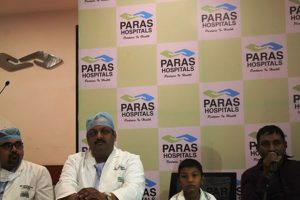Apr 25, 2022
9 year old boy given a ‘gift of life’ by doctors at Paras Hospitals, Gurgaon through Ross Procedure applied to treat his rare congenital heart condition

- The baby boy had two major types of heart defects since birth.
- The surgery conducted at the hospital helped him overcome the problems and bounce back to normal life.
In a landmark achievement in cardiac surgery, doctors at Paras Hospital, Gurgaon recently performed a successful heart surgery to treat a congenital and critical heart condition in a 9-year-old. The surgical procedure conducted to replace the diseased aortic valve by “Ross Surgery”, a procedure that includes replacement of the aortic valve inside one’s heart with the native pulmonary valve. The one-of-its-kind procedure was conducted by a team of highly qualified cardiac surgeons led by Dr. Vishal Agarwal, HOD-Cardiothoracic, and Vascular Surgery, Paras Hospitals, Gurgaon.
Sudip (name changed), the patient, was diagnosed with a congenital heart condition at birth itself. His condition severely limited his participation in normal daily life activities and normal growth as well before the surgery. He could hardly participate with his peers in activities that every normal child at his age would do.
Dr. Vishal Agarwal, HOD, Cardio Thoracic Vascular Surgery, Paras Hospitals, Gurgaon says, “When Sudip first came to our hospital, he complained of frequent breathlessness followed by pain and uneasiness in the chest. His parents, who had been told earlier on a number of occasions that their child’s lifespan may be limited, were extremely worried about their son’s apparently worsening heart condition. After assessing his medical records closely, we detected in him typical congenital aortic stenosis, a heart valve disorder that narrows the opening of the aortic valve, and consequently the flow of blood from heart does not go properly to the rest of the body. At the same time, we also found that he was having an abnormal patent tube connecting the descending thoracic aorta and the pulmonary artery, was adding to his problem. In this type of condition known as patent ductus arteriosus, oxygenated blood will start flowing in the wrong direction, thus weakening the heart muscle and leading to fatal complications.”
The position of aortic valve is of crucial importance in human body as it is a high pressure system valve which pumps blood for whole body. Diseases of aortic valve are life threatening in nature. The dual dilemma of two birth defects faced by the 9 -year-old kid were both pertaining to the aortic valve only, therefore increasing chances of heart failure and other complications at a very young stage.
“Here, the conventional thinking would be to replace the stenosed, chocked valve with an artificial metallic valve via an aortic valve replacement surgery, which is very common procedure in adults. However, in growing children, the metallic valve will fall short in the next 1-2 years because of increased body demand and body growth, and he may need another high risk operation soon after, increasing chances of sudden death. So, we decided to take an entirely different surgical approach in Sudip’s case,” added Dr. Vishal Agarwal.
The breakthrough approach that doctors took was the Ross Procedure, a type of specialized aortic valve surgery where the patient’s aortic valve is being replaced with his or her own pulmonary valve to fix a birth defect. Particularly in children, this ‘pulmonary autograft’ procedure offers long-term advantage over the traditional aortic valve replacement (with prostheses).

“In the Ross procedure, the diseased aortic valve is taken out and thrown away, and the pulmonary valve is surgically cut from its place and structured in the place of aortic valve. On the other hand, the pulmonary valve is replaced by artificial valve conduit made of bio material (harvested from the neck vein of buffalo), which has a shelf life of at least 10 years. The major benefit with this procedure in infants is that the replaced valves will grow parallely as the child grows. Also, this type of surgery reduces post-operative complications and there is no need to use anticoagulants for the rest of the life, unlike in persons undergoing mechanical valve replacement surgery. Given the adolescent age of the child, this one was very complex surgery as it could lead to blood clotting if not done properly. We are now glad to announce that the surgery has been completed successfully by our team, and Sudip was discharged only after a few days after the surgery,” explained Dr. Vishal Agarwal.
The Ross procedure demands a high level of skill and expertise to conduct it. Only in last decade, this procedure has been accepted and gained popularity in our country; but till date, not more than 10 centers in the private healthcare industry in India have carried out this type of surgery. With this milestone operation being done successfully in Sudip, Paras Hospitals has now joined the elite group. Notably, Dr. Agarwal of Paras Hospitals, Gurgaon has been actively performing a number of high-risk complex surgeries on domestic and international patients for more than 12 years now, and had been credited for doing the maximum number of CTVS cases in western UP.
Estimates reveal that around 1.5 lakh children born in a year in India with congenital heart disease. It accounts to major infant mortality among 0-5 year age group, mostly due to lack of awareness, diagnosis and proper treatment. Out of all such type of birth defects, the congenital aortic stenosis is still rare variant.
About Paras Hospitals Gurgaon
Paras Hospitals Gurgaon is 250-bedded flagship hospital of Paras Healthcare, and is the first NABH-accredited corporate hospital in Haryana. It is also the first hospital of the region to have a NABL accredited laboratory. The hospital has 9 centers of excellence and 55 super specialties. There are 64 critical care beds, 7 modular operation theatres, 24-hour emergency services. There is a fully-equipped cardiac cath lab, state-of-the-art cancer centre, dialysis and endoscopy suites, and a comprehensive blood bank. The hospital has been founded and managed by a doctor-entrepreneur, and is dedicated to changing the face of healthcare in India, by making it affordable and accessible.

